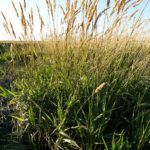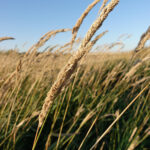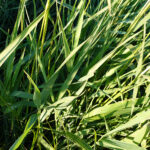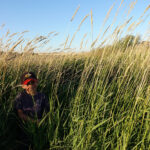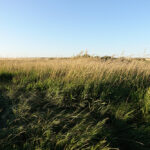Reed Canarygrass
Phalaris arundinacea L.
General Description
Reed canarygrass is a well-adapted, long-lived, cool season, perennial native grass with many tame varieties. It grows best in wet areas but also can tolerate some moist upland areas. This grass often grows on wet sites, and can indicate high soil moisture conditions where periodic flooding can occur for extended periods of time. Extensive sod-forming root systems are produced by crowns below the soil surface. The plant may appear to be bunched but actually produces large diameter, short rhizomes, which in turn produce new shoots and roots.
Stems are coarse and erect, growing up to 200 cm (79 in) tall. Leaves are pale green, large, flat, and wide up to 20 mm (3/4 in) wide. The spikelets of the seed head cluster alternately up the stem, producing purplish flowers. Seed shatters very easily, and germination ability declines soon after being shed. Select a tame reed canarygrass variety with low alkaloid levels for the best palatability and animal health.
Type
Native grass. Tame grass (introduced cultivars).
Origin
Native to North America. Varieties used in Canada originate from both North America and Europe. It is thought the hybridization of introduced and North American types has produced aggressive plants in central and western North America.
Longevity
At least 20 years.
At least 10 years.
Use
Pasture, hay, reclamation. As a high yielding grass with good regrowth it may be hayed in a two-cut system or grazed after haying.
Optimal Time of Use
Spring, summer, fall. Established stands can be grazed several times during the season, if kept in vegetative growth stages. Easily managed under rotational grazing, and more difficult to manage well under continuous grazing. As soon as reed canarygrass heads out, stems mature and become coarse causing a sharp decline in palatability. Hay at boot to heading to allow for quality and regrowth for a two-cut haying system.
Recovery After Use
Requires a minimum 30-45 days of recovery after use. Allow regrowth of about 30 cm (12 in) before regrazing lightly. Stands (sod-forming) resist animal traffic and hoof action but close grazing can slow growth.
Allow regrowth of about 30 cm (12 in) before regrazing lightly. Stands (sod-forming) resist animal traffic and hoof action but close grazing can slow growth.
Palatability/Nutritional Value
Crude protein of 12 to 15% and digestibility ranges from 55 to 65% early in the season, but protein and digestibility drop dramatically later in the season. Timing of use is important with reed canarygrass- in the vegetative stage palatability is high. As stems develop palatability decreases drastically and quality falls. Use alkaloid-free varieties registered in Canada to avoid problems with livestock grazing and alkaloid toxicity.
Annual Precipitation min/max (mm)
350mm / 1650mm- Requires high soil moisture.
Drought Tolerance
Moderate tolerance.
Flooding Tolerance
Withstands 5 weeks or more of flooding and grows well in waterlogged soils. It is best adapted to wet areas but can grow on moist upland areas.
Winter Hardiness
Good hardiness. Improved by allowing 4 weeks rest from grazing before killing frosts.
Soil Texture Preference
Most suited to loam through clay soils, but can adapt to any other soils where moisture is available. Most often seen in floodplains, creeks, sloughs, and riparian areas. Can be grown on moist uplands (Black and Grey soils).
Most suited to loam through clay soils, but can adapt to any other soils where moisture is available. Most often seen in floodplains, creeks, sloughs, and riparian areas.
Erosion Control
High erosion control. Thick sod and high competitive ability make this a good candidate for erosion control, especially in waterways and wetter areas.
Salinity Tolerance
Slight tolerance.
Acidity Tolerance
High tolerance. Tolerates soil pH values as low as 5.0.
Alkalinity Tolerance
Moderate tolerance.
Seeds per kg
1,186,000 seeds/kg (538,000 seeds/lb)
Suggested Mixtures
Seed with moisture tolerant legumes for hay or grazing. Often seeded as a monoculture in floodplains or riparian areas. Mixes will with bird’s foot trefoil, red clover for wet areas, and meadow brome grass and alfalfa for undulating topography.
Ease of Establishment
Since reed canarygrass seedlings cannot tolerate flooding, mid-summer seeding is optimal when soil moisture levels are lower and the chance of flooding is reduced. Stands can be thin in early years, but eventually fill in from strong rhizomatous growth. Young stands should not be grazed until they are well established and have developed a dense sod. When establishing new stands, use of pedigreed seed rather than common seed will reduce problems with alkaloids by ensuring that the alkaloid-free varieties are “true to variety”.
Competitiveness
Low competitiveness in early years, but highly competitive and aggressive once it is established. Invasiveness in many situations is considered moderate, as it can escape from pastures and spread into riparian areas, waterways, and wetlands.
Management Considerations
Seek out newer, alkaloid-free varieties for forage uses, or carefully manage the grazing period to avoid alkaloid toxicity in animals. Watch for alkaloid issues in stands established before the development of newer alkaloid-free varieties, especially during drought stress. Fencing wetter areas with reed canarygrass separately can help ensure that these areas are grazed properly to stay vegetative for maximum palatability. Older upland stands can be occasionally spiked, coultered, or knifed to cut roots and rhizomes and stimulate new growth.
British Columbia Rangeland Seeding Manual, Saskatchewan Dryland Forage Species Adaptation Tool, USDA Plants Database, Manitoba Forage Adaptation and Comparison Guide, Alberta Forage Manual
Reed canarygrass is adapted to all zones in the Central Interior where the site provides sufficent moisture, e.g., non-saline subirrigated meadows.
Reed canarygrass is adapted to all zones in the Southern Interior if the site provides sufficent moisture; non-saline subirrigated meadows, for example.
